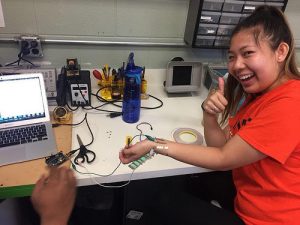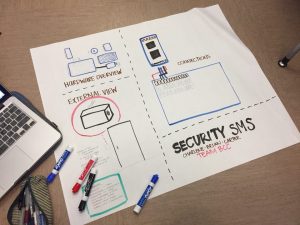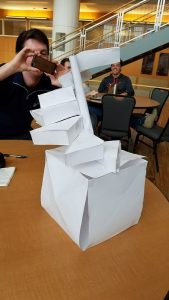With our class moving along with our team projects, week 9 was predominantly focused on moving forward with designing and creating prototypes of our products. Throughout the semester we have obtained a wide variety of learning experiences such as how to use 3D printing software such as TInkerCad / Fusion, how to program arduinos processing chips, and using the build capabilities at the campus Fab Lab. Having had weeks to begin to learn how use these tools allowed teams to think of ways to how they can create and improve their product design.

Testing of Hydration “Fit Bit”
In class teams sketched out first prototype designs of what each teams product is. To begin teams laid out specifically what the product does and what its purpose is. After knowing what functionality we needed out of our products, we than made a materials list of all the parts / components that would be necessary to obtain to make the product work. The products / problems teams are trying to solve are widely varied in what they do and how they are put together. Some products need arduinos, sensors, and have to be programmed through breadboards, while others could simply be 3D printed objects to solve a certain need. Each team in our class at the very least has a sketch of a prototype, and we have been in the works to create our first fully functioning version of our products. The class is very excited to start to create tangible versions of our prototypes through collaboration with 3D printers, the Fab Lab, and many other campus resources. Depending on the teams product, some teams have to obtain a wide variety of parts from Vishal, the Fab Lab, or even just ordering online in order to start creating the prototype. For other teams their may be more emphasis on design with 3D printing and testing the product in the field. One team for example is considering working on 3D printing custom cricket sporting equipment. They may not need to work with the Fab lab or programming, but they do need a heavy emphasis on getting the design and functionality correct for their end user.

Security System – Prototype Sketch & Materials list
Overall this week had a significant theme of the importance of the design of our product to fulfill a need. As one of the TED talks we listened to in class stated, “Design is best as an iterative process, the earlier you invite feedback, the more chances you have to revise and improve” (David Kelley Ideo). The design and creation of the prototype is the first step of many on the path to creating a successful product that end users will value. For many teams creating the first prototype was challenging in not knowing exactly what the product looks like or in some cases even works. Ultimately as Mr. David Kelley of Ideo highlights, the prototype is not meant to be perfect. In fact the prototype is simply the first step in allowing our products more changes to be improved through feedback and trial and error. Week 9 was significant for teams to begin development on creating, designing, and moving forward with creating a useful product that fulfills a need. It will be exciting to see how the prototypes are developed, and refined in this last month of the semester!


